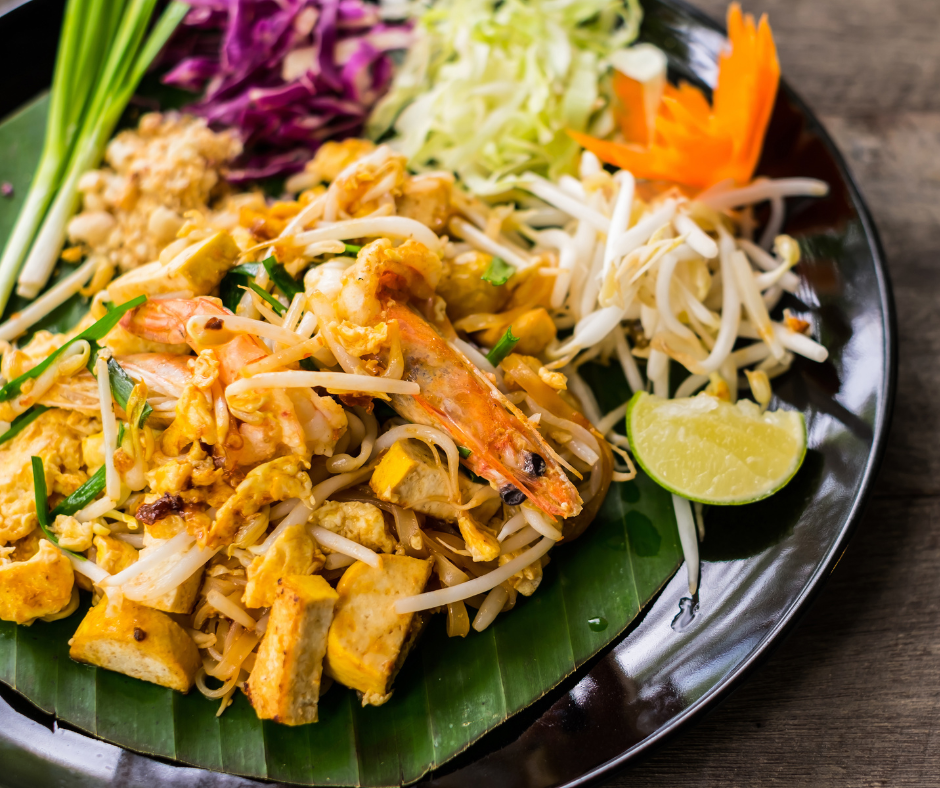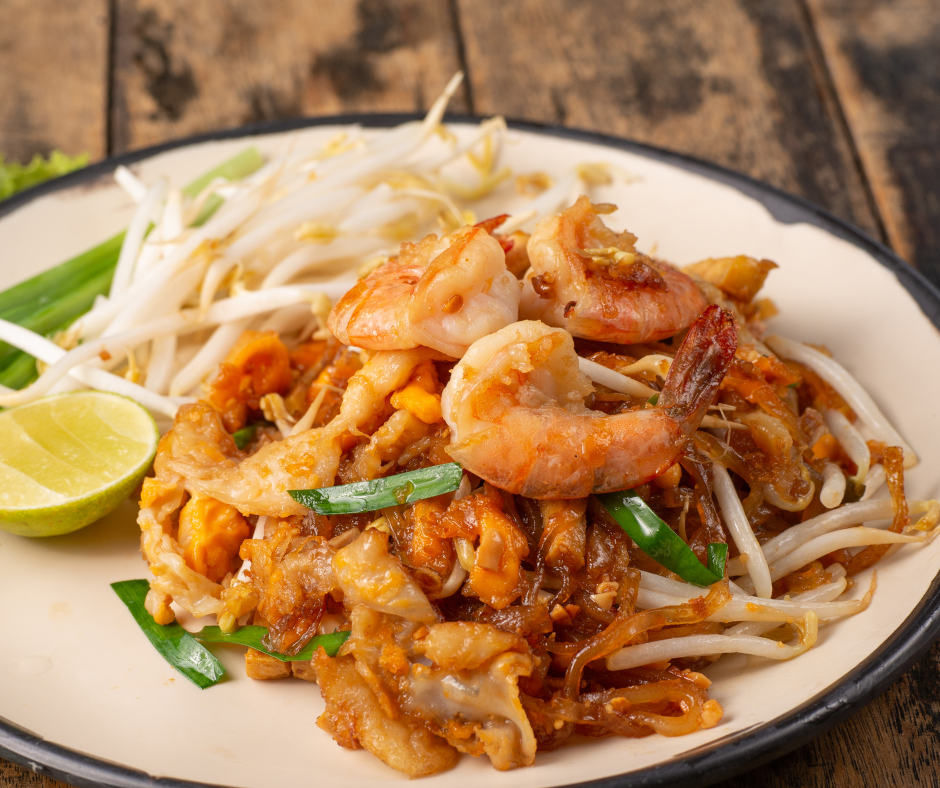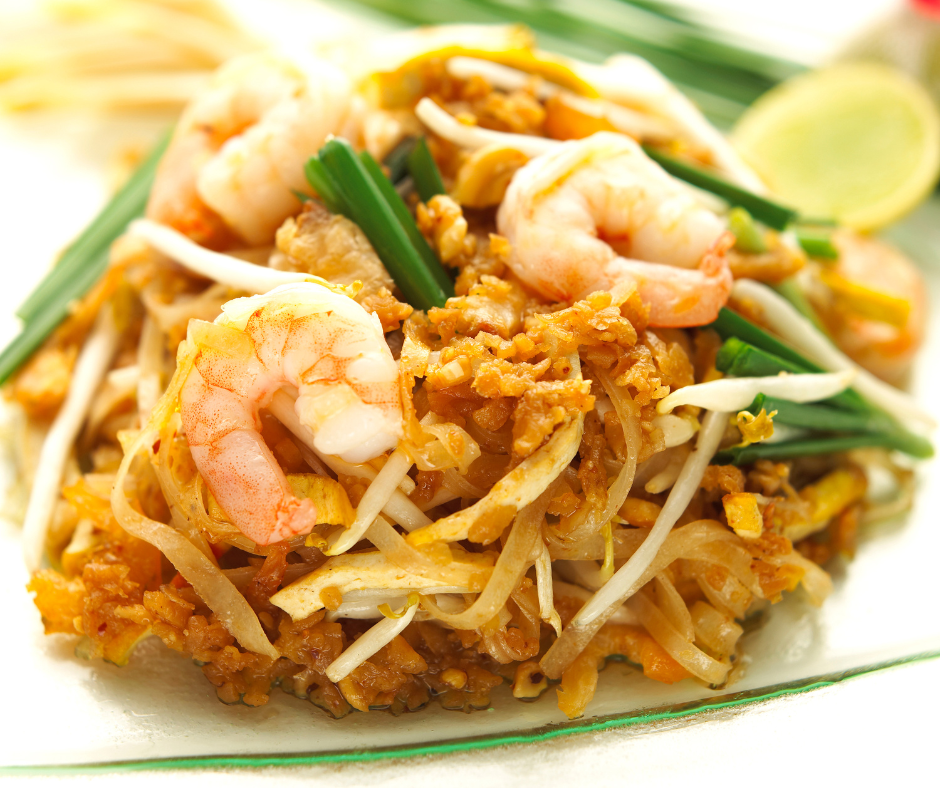Introduction
Introduction To Pad Thai And Its Popularity
Pad Thai is a popular stir-fried noodle dish that has gained immense popularity worldwide. It is typically made with rice noodles, stir-fried with eggs, tofu, shrimp or chicken, and bean sprouts, and flavored with a tangy combination of tamarind paste, fish sauce, and palm sugar. The dish is often garnished with crushed peanuts, lime wedges, and fresh herbs.
Pad Thai’s popularity stems from its delicious flavors, vibrant colors, and versatile nature. Its unique blend of sweet, sour, and savory flavors creates a mouthwatering taste that appeals to many palates. Moreover, it offers a perfect balance of protein, carbohydrates, and vegetables, making it a satisfying and well-rounded meal. But Is Pad Thai Healthy? This blog will answer the question for you.
Variations Of Pad Thai Across Restaurants
While Pad Thai is typically healthy and nutritious, its healthiness can vary depending on where it is prepared and the ingredients used. Pad Thai in traditional Thai restaurants often incorporates fresh and natural ingredients, focusing on balancing flavors and maintaining authenticity. These versions usually have less oil and added sugars, making them a healthier option.
However, in some Westernized or fast-food restaurants, Pad Thai can undergo modifications that may reduce its nutritional value. Some variations may include added sugars, unhealthy fats, or excessive amounts of oil, which can contribute to higher calorie content and less nutritional value.
To ensure that you are enjoying a healthier version of Pad Thai, you can consider these tips:
- Choose restaurants that focus on traditional Thai cuisine and use fresh ingredients.
- Request modifications such as less oil or a reduced amount of sugar.
- Opt for protein options like tofu or chicken instead of deep-fried items like battered shrimp.
- Control portions by sharing the dish or ordering a smaller portion size.
- Make Pad Thai at home using fresh ingredients and adjust the recipe to your dietary preferences.
In conclusion, Pad Thai can be a healthy and flavorful dish when prepared with fresh ingredients and by traditional Thai cooking techniques. By being mindful of the ingredients and cooking methods used, you can enjoy the deliciousness of this Thai classic without compromising your health.
Nutritional Profile Of Pad Thai
Whether you’re a fan of Thai cuisine or simply looking for a tasty meal option, you may have wondered: Is Pad Thai healthy? Let’s take a closer look at the nutritional profile of this Thai classic.
Calories And Macro-nutrients In A Typical Serving Of Pad Thai
A typical serving of Pad Thai, which usually includes stir-fried rice noodles, eggs, tofu or shrimp, bean sprouts, peanuts, and various vegetables, provides approximately 300-400 calories. The exact calorie count can vary depending on the portion size and specific ingredients used.
Regarding macro-nutrients, Pad Thai balances carbohydrates, protein, and fats. The carbohydrates primarily come from rice noodles and vegetables, providing energy for the body. The protein content can vary depending on whether tofu or shrimp is the main protein source. Additionally, the presence of peanuts contributes healthy fats to the dish.
The Impact Of Oil And Peanuts On Calorie Content
It’s important to note that using oil and peanuts in Pad Thai can significantly affect calorie content. This dish is typically stir-fried in oil, which adds additional calories. However, it’s worth mentioning that Pad Thai is usually prepared with small amounts of oil, making it a relatively moderate source of added fats.
Peanuts are a common ingredient in Pad Thai, adding flavor and texture. While peanuts are a nutrient-dense food and provide some healthy fats, they also contribute to the calorie content of the dish. If you’re watching your calorie intake, consuming Pad Thai in moderation may be helpful, or opt for a version with fewer peanuts.
Overall, Pad Thai can be a part of a healthy and balanced diet when consumed in moderation. To make it even healthier, consider choosing versions that incorporate more vegetables or lean protein sources, like tofu or chicken. Additionally, portion control and mindful eating can help you enjoy this Thai classic while maintaining a balanced lifestyle.
Is Pad Thai Healthy? – Health Benefits Of Pad Thai
Nutrient-dense Ingredients In Pad Thai
Pad Thai is popular for its flavorful combination of noodles, vegetables, and protein. While it is a delicious meal, many people wonder if it is also healthy. The good news is that Pad Thai can offer several health benefits due to its nutrient-dense ingredients.
One of the key ingredients in Pad Thai is rice noodles, a gluten-free alternative to traditional wheat noodles. These noodles are a good source of carbohydrates, providing the body with energy. Additionally, Pad Thai typically includes a variety of vegetables, such as bean sprouts, carrots, and green onions. These vegetables are rich in vitamins, minerals, and antioxidants, which can support overall health and protect against chronic diseases.
Pad Thai As A Source Of Protein, Fiber, And Essential Nutrients
Another important component of Pad Thai is the protein. It is typically made with tofu or shrimp but can also be customized with chicken or beef. Protein is essential for building and repairing tissues, promoting satiety, and supporting muscle health. Including protein in Pad Thai makes it a balanced and satisfying meal option.
Furthermore, Pad Thai contains peanuts or peanut sauce, which adds a creamy texture and a nutty flavor. Peanuts are a good source of healthy fats, fiber, and protein. These components can help improve heart health, regulate blood sugar levels, and promote satiety.
Pad Thai can be a nutritious meal option when prepared with fresh and wholesome ingredients. However, it is important to note that the healthiness of Pad Thai can vary depending on the cooking method and additional ingredients used. It’s advisable to choose restaurants or recipes that prioritize fresh ingredients, minimize the use of added sugars or unhealthy fats, and offer options for customization.
In conclusion, while Pad Thai is a delicious and flavorful dish, it can also provide several health benefits. Its nutrient-dense ingredients, such as rice noodles, vegetables, protein, and peanuts, offer a variety of essential nutrients, fiber, and protein. As with any dish, choosing high-quality ingredients and practicing portion control is important to maintain a balanced and healthy diet.
Concerns About Pad Thai Nutrition
Pad Thai is undeniably a popular and beloved Thai dish, known for its harmonious blend of flavors and satisfying combination of noodles, vegetables, and protein. However, many people may wonder about its nutritional value. Is Pad Thai healthy, or should it be regarded as an indulgence? Let’s delve into the healthiness of this Thai classic.
The Presence Of Sugar In Pad Thai
One of the primary concerns about Pad Thai nutrition is its sugar content. Traditional Pad Thai sauce typically includes a sweet element, such as palm sugar or tamarind paste, to balance the dish’s flavors. While some sugar is inevitable, the amount can vary depending on the recipe and preparation.
To mitigate the sugar intake, you can make healthier adjustments when preparing Pad Thai at home. Use less sugar or opt for natural sweeteners like honey or maple syrup. Additionally, consuming Pad Thai in moderation can help manage sugar intake while enjoying its delicious flavors.
Sodium Levels In Pad Thai And Its Effect On Salt Intake
Another aspect to consider is the sodium content of Pad Thai. Soy sauce, fish sauce, and other flavoring ingredients used in the dish can contribute to high sodium levels. Excessive sodium intake can lead to health issues like high blood pressure.
To reduce sodium intake, you can:
- Choose low-sodium soy sauce or tamari as an alternative.
- Request less salt or soy sauce when ordering Pad Thai at restaurants.
- Prepare the dish at home, allowing you to control the amount of sodium added to the recipe.
By making these adjustments, you can still savor the flavors of Pad Thai while being mindful of your salt intake.
Despite these concerns, Pad Thai can also offer some nutritional benefits. It typically contains a variety of vegetables that provide essential vitamins, minerals, and fiber. Additionally, including lean protein sources like chicken, shrimp, or tofu can contribute to a balanced meal.
It’s important to approach Pad Thai like any other dish – as part of a well-rounded diet. While indulging in Pad Thai occasionally is fine, moderation and mindful choices are key. Balanced portion sizes and selecting healthier ingredients can help make Pad Thai a delicious and relatively healthy option.
Pad Thai And Dietary Preferences
Pad Thai is a classic Thai dish with international popularity for its unique blend of flavors and textures. However, the question arises for health-conscious individuals: is Pad Thai healthy? Let’s uncover the healthiness of this Thai favorite.
Options For Customization And Healthier Versions Of Pad Thai
When it comes to Pad Thai, there are several ways to make it healthier without sacrificing taste. Here are some options for customization:
- Choose lean protein: Opt for grilled chicken, shrimp, or tofu as your protein source instead of fatty meats like pork or beef. This will reduce the overall fat content of the dish.
- Increase vegetable content: Add colorful vegetables, such as carrots, bell peppers, and broccoli, to boost the dish’s nutritional value. These vegetables provide essential vitamins, minerals, and fiber.
- Use whole grain noodles: Substitute traditional rice noodles with whole grain or even zucchini noodles for a lower carbohydrate and higher fiber option.
- Control portion sizes: Pad Thai can be a calorie-dense dish, so it’s important to be mindful of portions. Enjoy it as a main course and pair it with steamed vegetables or a salad to create a well-balanced meal.
Alternative Thai Dishes With Lower Calorie Content
If you are looking for even lighter options, other Thai dishes are naturally lower in calorie content. Consider trying the following alternatives:
- Tom Yum Soup: This hot and sour soup contains flavorful herbs, spices, and vegetables. It is typically low in calories and can be enjoyed with added protein like shrimp or tofu.
- Green Papaya Salad (Som Tum): Made with shredded green papaya, tomatoes, and peanuts, this refreshing salad is a healthier alternative to heavier noodle dishes. It offers a balance of sweet, sour, and spicy flavors.
- Grilled Satay Skewers: Skewers of marinated chicken, beef, or shrimp grilled to perfection and served with a flavorful peanut sauce can be satisfying and protein-rich.
- Stir-Fried Mixed Vegetables: A colorful and nutritious dish that combines various vegetables stir-fried in a light sauce. This option is low in calories and high in vitamins and minerals.
In conclusion, Pad Thai can be a part of a healthy diet if made with the right ingredients and portion sizes. However, alternative Thai dishes are also available that are naturally lower in calorie content for those seeking lighter options. It’s all about making informed choices and balancing your overall dietary preferences and goals.
FAQ: Is Pad Thai Healthy? Unveiling the Healthiness of a Thai Classic
Q: What is Pad Thai?
A: Pad Thai is a traditional Thai noodle dish made with stir-fried rice noodles, shrimp, tofu, bean sprouts, egg, and a tangy sauce. It is a popular dish known for its unique blend of flavors and textures.
Q: Is Pad Thai considered a healthy dish?
A: While Pad Thai can be a delicious and satisfying meal, its health depends on various factors such as its ingredients, portion size, and cooking methods.
Q: Does Pad Thai contain a lot of calories?
A: The calorie content of Pad Thai can vary depending on the specific recipe and serving size. On average, a serving of Pad Thai contains around 400-500 calories. However, this is only a rough estimate, so it’s important to check the nutritional information provided for accurate details.
Q: Can Pad Thai be high in fat?
A: Traditional Pad Thai does contain some fat, mainly from the oil used in the stir-frying process. However, the amount of fat can be controlled by using healthier oils, reducing the oil quantity, or opting for a lighter cooking method such as steaming or boiling.
Q: Does Pad Thai have a high sugar content?
A: The sweetness in Pad Thai usually comes from the sauce, which can contain sugar. However, the overall sugar content can vary depending on the recipe and the amount of sauce used. If you are concerned about the sugar content, you can try making a homemade sauce with reduced sugar or look for healthier store-bought options.
Q: Does Pad Thai have any nutritional value?
A: Yes, Pad Thai does offer some nutritional value. It contains carbohydrates from the rice noodles, protein from ingredients like shrimp, tofu, or chicken, and vitamins and minerals from vegetables. However, the nutrient content may vary based on the recipe and ingredients used.
Q: Are there any healthier alternatives to Pad Thai?
A: If you’re looking for a healthier alternative, you can try making Pad Thai with brown rice noodles or even zucchini noodles (zoodles) to incorporate more fiber and nutrients into the dish. You can also add more vegetables and lean protein for a well-rounded and nutritious meal.
Q: Can Pad Thai be suitable for vegetarian or vegan diets?
A: Yes, Pad Thai can be modified to suit vegetarian or vegan diets. By omitting ingredients like shrimp or eggs and using tofu or more vegetables as a protein source, you can create a delicious plant-based version of this classic dish.
Q: How can I make Pad Thai healthier?
A: To make Pad Thai healthier, you can:
- Use whole grain or alternative noodles for added fiber.
- Load up on vegetables for more nutrients.
- Opt for lean protein sources like chicken, tofu, or seafood.
- Use less oil or choose healthier oils for stir-frying.
- Limit unnecessary additives like excessive sauces or MSG.
Conclusion
Now you should know the answer to ‘Is Pad Thai Healthy?’. After exploring the healthiness of Pad Thai, it is clear that this Thai classic can be a healthy and balanced meal option when made with fresh ingredients and prepared mindfully.
Final Thoughts On The Healthiness Of Pad Thai
While Pad Thai may not be the healthiest dish at a Thai restaurant, it can be enjoyed as part of a nutritious diet. You can create a healthier version of Pad Thai that satisfies your taste buds by making a few tweaks and choices.
Here are some tips to make your Pad Thai healthier:
- Choose whole wheat noodles or rice noodles: These options have a higher fiber content than regular white rice noodles, which can help you feel more satisfied and provide more nutrients.
- Use lean protein: Opt for grilled chicken, shrimp, or tofu as your protein source instead of fried or fatty meats. This will reduce the overall fat content in your dish.
- Load up on vegetables: Add colorful vegetables to your Pad Thai for nutrients and fiber. Carrots, bell peppers, broccoli, and bean sprouts are great options.
- Control the sauce: Limit the sauce used in your Pad Thai to reduce the sodium and sugar content. Consider making your sauce using healthier ingredients like low-sodium soy sauce, lime juice, and a small amount of natural sweetener.
- Watch your portion size: Pay attention to the serving size of your Pad Thai and try to eat mindfully. Enjoy your meal slowly and stop eating when you feel comfortably full.
Understanding The Balance Between Taste And Nutritional Value
It’s important to remember that food is not just about its nutritional value but also about enjoyment and satisfaction. Pad Thai is a beloved Thai classic known for its delicious flavors and unique combination of ingredients. While it may not be the healthiest dish in its traditional form, it can still be part of a well-balanced diet when consumed in moderation and with mindful choices.
The key is to find a balance between taste and nutritional value. By making small adjustments and incorporating healthier ingredients, you can transform Pad Thai into a nutritious and satisfying meal that you can enjoy without guilt.
So, the next time you’re craving Pad Thai, indulge in this flavorful dish. Remember to make mindful choices and enjoy it as part of a diverse and balanced diet.
Sources:



